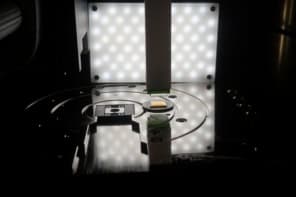Insulators play a key role in many electronic devices, but their very lack of conductivity makes it difficult to establish their electrical properties on the atomic scale. Now Kirill Bobrov and colleagues at the Université Paris-Sud have successfully used scanning tunnelling microscopy - which usually only works for conductors - to image the atoms on the surface of a diamond. The researchers believe that the technique could be extended to other insulating materials in the quest for ever-smaller electronic gadgets (K Bobrov et al 2001 Nature 413 616).
Scanning tunnelling microscopy is a powerful tool for mapping the contours of surfaces on the atomic scale. A fine metallic tip hovers just above the surface of the sample, and a voltage is applied across the tip and the sample. This makes the electrons quantum mechanically ‘tunnel’ across the gap between the tip and the sample, and this registers a current that depends on the size of the gap. The current measurements obtained as the tip moves across the material allow a picture of the surface to be built up. But the technique is unsuitable for insulators because they do not allow this current to flow.
But Bobrov and colleagues found that they could image certain planes of the diamond crystal if they applied a much higher voltage between the tip and the sample. Diamond has a ‘work function’ of 5.3 volts – that is, a voltage of 5.3 volts is needed to eject electrons from the material. When the team applied a higher voltage, they found that electrons jumped from the tip of the scanning tunnelling microscope into the conduction band of the diamond, allowing it to conduct electricity. The scanning tunnelling microscope registered a current of about 1 nanoamp and the team were able to obtain an image of the diamond surface.
According to the Paris team, this ‘resonant electron injection’ technique should allow physicists to map the surfaces of other insulators and determine their electrical characteristics, if they have a suitable band gap structure.



